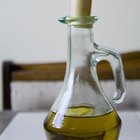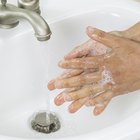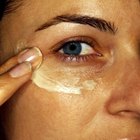Ointments are creams often used topically to soothe the skin. Usually, they contain a medication that is meant to treat certain conditions, such as burns or scrapes, and ward off infection. Sometimes, the ingredients in an ointment can adversely affect the skin, causing irritation or discomfort. When this happens, it is important to remove the cream right away to avoid further damage. If an ointment touches a fabric, such as clothing, it can also be removed with a few simple steps.
Removing ointment from skin.
Gently wipe away the ointment from the skin with a soft cloth or tissue.
Rinse the area with a clean saline solution. It is best to use saline because plain water will cause a painful burning sensation when applied to open wounds.
Wash the skin with a small amount of mild soap and clean water. For delicate wounds, use your hand to lightly rub the ointment off, or if there is not an open wound and you will not cause further damage, rub the area with a soft cloth to remove all traces of the ointment.
Pat the skin dry, trying not to rub, as this can exacerbate a skin condition.
Remove ointment from fabric.
Scrape off the excess ointment on the surface of the fabric with a spoon.
Sprinkle an absorbent powder, such as baking soda, onto the surface of the fabric to soak up the oils in the ointment.
Apply mild soap, such as a dishwashing detergent, to a soft cloth and rub into the fabric using a circular motion. If the fabric is delicate, rub the cloth in one direction, not in a back and forth motion, to avoid causing damage. Let the soap sit for five minutes.
Run hot water into a sink and squirt a few drops of mild soap into the water. Place the fabric in the water to soak for at least half an hour to allow the water and soap to penetrate the stain. If the stain is on an area of furniture or carpet that cannot be soaked, pour hot water from a height of two feet over the stain.
Using a brush, rub the area with a brush to remove any existing stains from the ointment. Rinse one last time under running water or pour more water over the area, then soak up the moisture with a dry towel. Allow the area to dry before reusing.
Related Articles

How to Heal an Inflamed Bikini Area

How to Remove the Smell of Cologne From ...

How to Heal a Bikini Razor Burn

Chamomile Essential Oil Benefits

Remedies for Unblocking Stubborn ...

How to Spot Clean a Taffeta Wedding ...

How to Make Temporary Tattoos Last ...

Tea Tree Oil as a Natural Remedy for ...

How to Remove Olive Oil From Suede

How to Cure Razor Burn on a Woman's ...

How to Remove Perianal Hair

How to Prevent the Discoloration of ...

How to Remove Ink From Nylon

How to Get Rid of Irritation From ...

How to Use Colloidal Silver to Kill ...

The Best Facial Moisturizer That Won't ...

The Best Way to Remove Hair Dye

How to Get Rid of a Tattoo Scab

How to Soothe Waxed Skin

How to Have Flawless Armpits
References
Writer Bio
Gail Logan is a magazine editor and freelance writer based in Atlanta, AL. She received her B.A. in Journalism from Patrick Henry College. For the past four years, she has written home design, travel and food features for national magazines, including "Coastal Living," "Texas Home and Living," "Log Home Design," and "Country's Best Log Homes." When not writing, she mentors inner-city children.